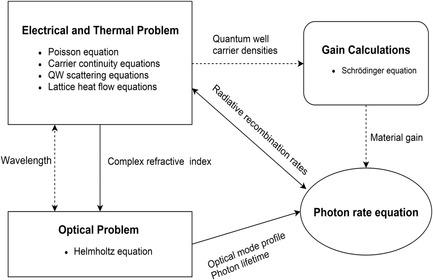当前位置:
X-MOL 学术
›
Phys. Status Solidi A
›
论文详情
Our official English website, www.x-mol.net, welcomes your
feedback! (Note: you will need to create a separate account there.)
Philosophy of Approaching a Laser Design Problem: Illustrated by the Design of Ultraviolet Vertical‐Cavity Laser Diodes
Physica Status Solidi (A) - Applications and Materials Science Pub Date : 2020-08-06 , DOI: 10.1002/pssa.202000154 Karan Mehta 1, 2 , Paul Douglas Yoder 1
Physica Status Solidi (A) - Applications and Materials Science Pub Date : 2020-08-06 , DOI: 10.1002/pssa.202000154 Karan Mehta 1, 2 , Paul Douglas Yoder 1
Affiliation

|
The objective of this article is to demonstrate a general approach to the problem of designing a novel laser diode. This involves first understanding prior work in this and related fields (literature survey), and then acquiring a thorough understanding of the relevant physics. This in turn enables the development and/or selection of appropriate models and tools for that problem followed by partitioning the problem into smaller solvable chunks. This involves identifying the key contributing factors affecting poor laser performance (sources of optical loss, poor injection efficiency, high thermal resistance, etc.), quantifying and ranking their relative importance, and finally finding solutions to these problems. The final step involves putting all these pieces back together to arrive at the final laser design. This step is challenging due to the strong coupling between electrical, optical, and thermal physics in a laser diode. Any design changes must be considered through all three lenses. Herein, this approach to laser design will be demonstrated in the context of a novel III–N‐based ultraviolet vertical‐cavity surface‐emitting laser diode (UV‐VCSEL).
中文翻译:

解决激光设计问题的理念:以紫外垂直腔激光二极管的设计为例
本文的目的是演示一种解决新型激光二极管问题的通用方法。这包括首先了解该领域和相关领域的先前工作(文学调查),然后获得对相关物理学的透彻理解。反过来,这使得能够开发和/或选择针对该问题的适当模型和工具,然后将问题分为较小的可解决块。这涉及确定影响不良激光性能(光学损耗,不良注入效率,高热阻等)的关键因素,量化和排名其相对重要性,最后找到解决这些问题的方法。最后一步涉及将所有这些部件放回原处,以进行最终的激光设计。由于激光二极管中电,光和热物理之间的强耦合,因此这一步骤具有挑战性。所有三个镜头都必须考虑任何设计更改。在此,将在新型的基于III–N的紫外垂直腔表面发射激光二极管(UV-VCSEL)的背景下演示这种激光设计方法。
更新日期:2020-09-21
中文翻译:

解决激光设计问题的理念:以紫外垂直腔激光二极管的设计为例
本文的目的是演示一种解决新型激光二极管问题的通用方法。这包括首先了解该领域和相关领域的先前工作(文学调查),然后获得对相关物理学的透彻理解。反过来,这使得能够开发和/或选择针对该问题的适当模型和工具,然后将问题分为较小的可解决块。这涉及确定影响不良激光性能(光学损耗,不良注入效率,高热阻等)的关键因素,量化和排名其相对重要性,最后找到解决这些问题的方法。最后一步涉及将所有这些部件放回原处,以进行最终的激光设计。由于激光二极管中电,光和热物理之间的强耦合,因此这一步骤具有挑战性。所有三个镜头都必须考虑任何设计更改。在此,将在新型的基于III–N的紫外垂直腔表面发射激光二极管(UV-VCSEL)的背景下演示这种激光设计方法。










































 京公网安备 11010802027423号
京公网安备 11010802027423号